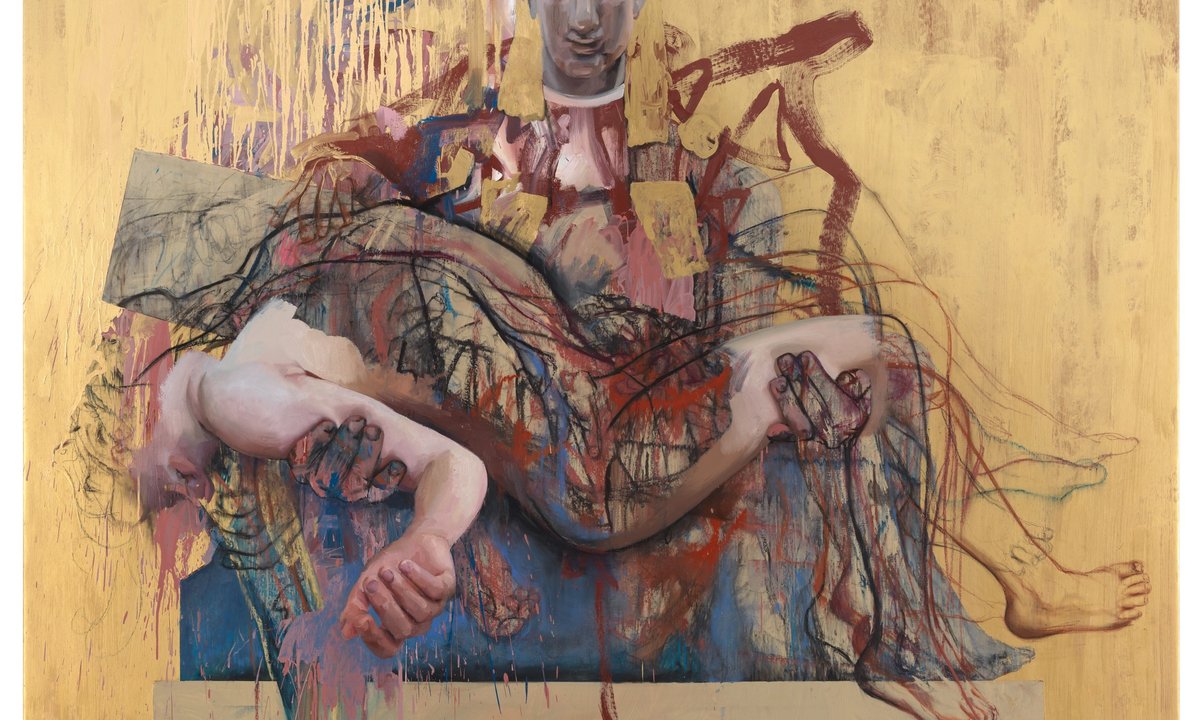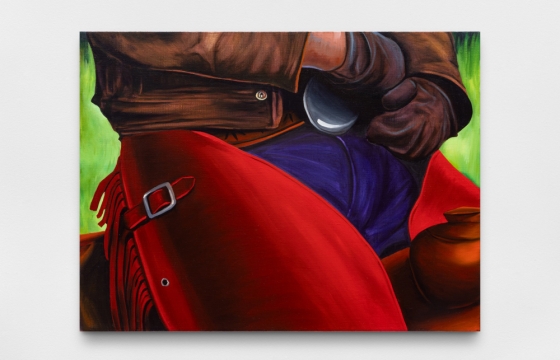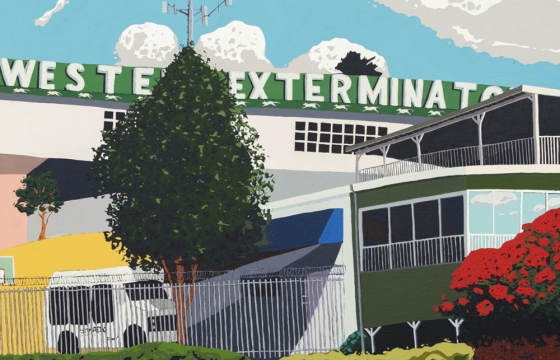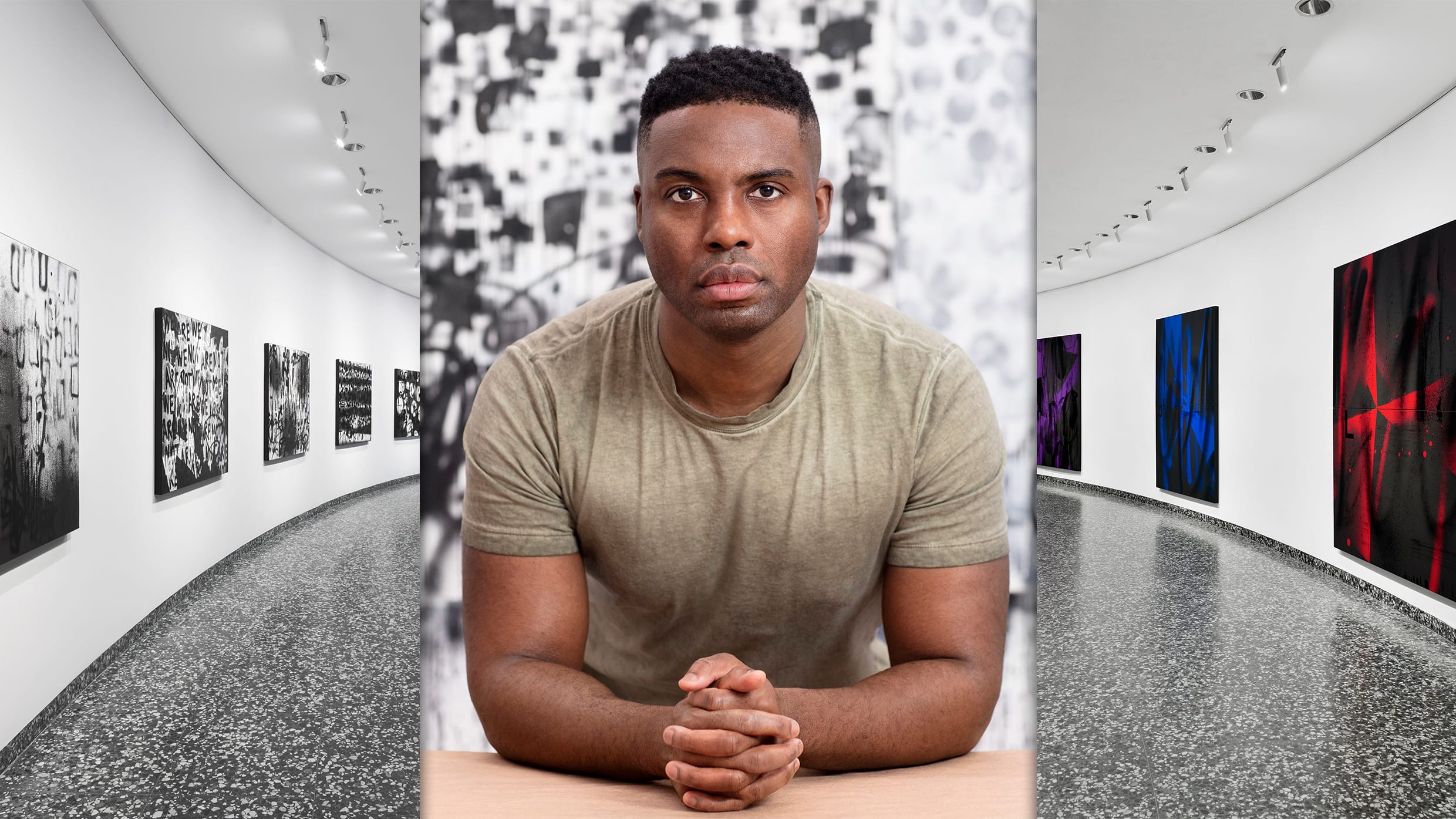#contemporary-painting
#contemporary-painting
[ follow ]
#surrealism #exhibition #art #installation #sculpture #perception #still-life #historical-memory #artistic-process
fromHi-Fructose Magazine - The New Contemporary Art Magazine
1 day agoTropical Flavored Nightmare: Sean Norvet's Paintings Are Reflective Mountains of Disgusting Excess - Hi-Fructose Magazine
Some of the original concepts were let go because I couldn't execute them the way I envisioned them. I think that's just part of the process for a lot of artists though. Some ideas sound great initially, but have trouble connecting once they start. That's where "intuition" comes in and I just try to not overthink anything and work. I usually start with an initial plan and over time, instinct kicks in and it becomes a completely different painting.
Arts
Arts
fromThe Art Newspaper - International art news and events
3 days agoLate UK artist Sarah Cunningham honoured with Nottingham Contemporary show
Nottingham Contemporary will present the first institutional solo exhibition of British artist Sarah Cunningham, opening next autumn, the largest presentation of her work to date.
fromBOOOOOOOM!
1 week ago"Western (re)Vision" by Artist Kevin Bell
I have chosen to paint many elements incompletely, in fragmented splatters, drips, and glazes to emphasize their lack of solidity and definitiveness. From these fragments, our cultural needs and desires are often revealed: movement, disposability, convenience. While not majestic or inherently aesthetic, I try to paint these banal places with a degree of sympathy. In some sense, it is an attempt to try to love this strange world we have created. The views in these paintings were selected because they have historical roots.
Arts
fromJuxtapoz
3 weeks agoJuxtapoz Magazine - Imminence: Siro Cugusi @ Bowman Hal, Madrid
The show brings together a selection of works, most of them large-scale, in which Cugusi unfolds his distinctive visual universe: reinvented landscapes, reconfigured classical symbolism, and scenes that expand the boundary between the real and the imagined. In Imminence, each work functions as a visual poem that invites viewers to abandon strict logic and step into a territory where emotion and intuition build worlds that evoke possible -and potentially imminent- futures.
Arts
fromBOOOOOOOM!
3 weeks ago"Too Bad, So Sad, Maybe Next Birth" by Artist Shyama Golden
A selection of recent paintings by Sri Lankan-American artist Shyama Golden. Born in Texas, Golden's work utilizes world-building and narrative to reveal the constructed nature of identity. The series, "Too Bad, So Sad, Maybe Next Birth," exhibited at PM/AM gallery in London earlier this year. The paintings follow the idea of past lives and deaths as Golden charts her own over the past 200 years.
Arts
fromJuxtapoz
1 month agoJuxtapoz Magazine - Motion Pictures: Sean Downey @ LaMontagne Gallery, Boston
LaMontagne Gallery is pleased to present Motion Pictures, a solo exhibition of new paintings and sculptures by Sean Downey. The work uses images and forms as proxies for a feeling sense about time. Distinctions between the political, cultural, historical, and autobiographical become fluid, and imagery arises that seems almost to tell a story yet is primarily aimed at evoking sensation - particularly one that embraces contradiction.
Film
fromThe Art Newspaper - International art news and events
1 month agoMarlene Dumas becomes first contemporary woman artist to join Louvre's permanent collection
My faces are a mixture of the past and the present. I cannot paint the horrors of the ongoing genocides of our times directly, but their shadows did affect the mood under which these faces were made. Portraiture deals with likeness and the recognition of people known. Faces deal with the nameless. They include those dehumanised, like fugitives, branded as aliens.
Arts
Arts
fromJuxtapoz
1 month agoJuxtapoz Magazine - Jeanette Mundt: Divorce Paintings @ Company Gallery, NYC
Jeanette Mundt re-centers painting's physical life, using canonical genres and material experimentation to interrogate memory, movement, and contemporary tensions through layered, tactile surfaces.
fromKALTBLUT Magazine
1 month agoCHRONOSTASIS: When Time Takes a Breather! Galerie Sara Lily Perez presents Rene Wirths & Wolfgang Flad in Dialogue - KALTBLUT Magazine
Opening on November 14, 2025, at the gallery's Bikini Berlin location, this immersive showcase invites visitors to explore the intricate relationship between perception, stillness, and the malleable nature of time. Drawing inspiration from the phenomenon of chronostasis, where a fleeting moment appears to elongate, the exhibition encapsulates the delicate dance between motion and remembrance. Through their distinctive practices, Wirths and Flad illuminate how focused attention can metamorphose our experience of time itself.
Arts
Arts
fromHi-Fructose Magazine - The New Contemporary Art Magazine
1 month agoHappy Crying: The Art of Rachel Hayden Balances Tension With Whimsy - Hi-Fructose Magazine
Rachel Hayden's paintings fuse whimsy and tension through peculiar motifs, symmetry, and disassociated figures while she balances art practice with assistant work and studio time.
fromColossal
1 month agoSocial Realism and the Surreal Converge in Bryce Wymer's Evocative Sketchbooks
Whether working on large-scale commissions or more intimate drawings, sketchbooks remain Wymer's primary jumping-off points. "I've been keeping sketchbooks since middle school, when I filled them with graffiti tags, local DIY show flyer ideas, and zine layouts," Wymer tells Colossal. "Over the years, they've evolved from casual notebooks into an essential part of my creative process. I carry one with me at all times, and without it, I feel pretty untethered."
Arts
fromstupidDOPE | Est. 2008
2 months agoLee Madgwick's Surreal Structures Capture the Beauty and Unease of Isolation | stupidDOPE | Est. 2008
Under skies heavy with storm-gray clouds, the architectural ruins in Lee Madgwick's paintings seem to exist somewhere between reality and imagination. His works are not just landscapes but psychological portraits-of solitude, fragility, and the strange poetry found in decay. With a style that merges surrealism and realism in equal measure, Madgwick transforms the familiar English countryside into a dreamlike world that's quietly charged with tension.
Arts
fromThe Art Newspaper - International art news and events
2 months agoFondation Louis Vuitton in Paris stages epic Gerhard Richter retrospective
Gerhard Richter turned 93 this year, and has still been hard at work. Though he officially gave up painting in 2017, with a final sequence of elaborate abstracts, he has recently been turning out small, exquisite, painterly works on paper. And now the full range of his very long career, from his breakthrough photographic paintings of the 1960s to last year's ink-cloud drawings,
Arts
fromJuxtapoz
2 months agoJuxtapoz Magazine - Luke Rogers "Coughing in the Pipes" @ Moskowitz Bayse, Los Angeles
"Water is important to people who do not have it," Joan Didion wrote, "and the same is true of control." She was talking about California, and the impressive machinery-"the aqueducts and siphons and pumps and forebays and afterbays and weirs and drains"-that has, since the early 20th Century, made American life as we know it to be plausible in the West.
Arts
fromBOOOOOOOM!
2 months ago"The Unsaid Remains Remembered" by Artist Sophie-Yen Bretez
A new body of work exploring moments when spaces shift and time overlaps by Paris-based artist Sophie-Yen Bretez. "The Unsaid Remains Remembered" represents what Bretez calls a "dramaturgy of passage." Working with shaped canvases and large-scale compositions, she turns everyday objects into symbolic thresholds guiding the viewer between intimacy and vastness, presence and absence. Horizons of changing skies and seasons coexist with traces of the body-reflections, bite marks, stains-where ambiguity unsettles.
Arts
Arts
fromThe Art Newspaper - International art news and events
2 months agoA brush with... Christopher Wool-podcast
Christopher Wool probes paint's materiality, chance, and language across painting, photography, and sculpture, repurposing imagery while drawing inspiration from jazz and diverse cultural sources.
fromJuxtapoz
2 months agoJuxtapoz Magazine - November Comes Early: Lenz Geerk @ MASSIMODECARLO, London
The exhibition gathers three strands - haircuts, still lifes, and a storefront - into a single season, a climate of attention for small, ordinary acts. In the haircut series, intimacy is staged at close range: a pair negotiating blades and trust, one seated in vulnerability, the other holding the shears. The vertical format elongates the encounter, turning an ordinary trim into something ritualistic, even a little dangerous. Flesh tones are chalky, almost earthen, as if the body were drawn from the ground.
Arts
fromJuxtapoz
2 months agoJuxtapoz Magazine - Preview: Riikka Sormunen "Only Lovers" @ Richard Heller Gallery, Santa Monica
Only Lovers began with the idea of theatre. I built myself a nest of hours on the stage: a place where everything is carefully planned, placed and rehearsed. Every character is aware of the viewer, posing with emotions from a script of confessions and fantasies. The scenes are set by the sea, on various beds, with pareidolic jokes making their shy appearances.
Arts
fromDocumentjournal
2 months agoThe boy that don't bleed
Caleb Hahne Quintana paints in the sun-bleached palette of his native Colorado. From afar, his canvases seem effortless in their clarity; up close, layers of paint dragged, blended, and muddied into hundreds of subtle shades resolve into a single limb or a patch of sky. His latest series, A Boy That Don't Bleed, on view at Anat Ebgi through October 18, 2025, pushes this concern with paint into new psychic terrain.
Arts
fromwww.theguardian.com
2 months agoI Gusti Ayu Kadek Murniasih review a vivid testament to a life lived hornily
Murni or I Gusti Ayu Kadek Murniasih, to go by her full name was a Balinese artist who shrugged off all the norms and expectations that life chucked at her and instead made art with total abandon. By the time she died aged 39 in 2006, taken by ovarian cancer, she'd left behind a body of ultra-simple, mega-bold, hyper-colourful painting that functions as a testament to a life lived honestly, independently and very, very hornily.
Arts
Arts
fromstupidDOPE | Est. 2008
3 months agoPablo Benzo's "Time Traveler and Other Fragile Detours" Opens at The Hole | stupidDOPE | Est. 2008
Pablo Benzo's New York solo exhibition reanimates European modernism through dreamlike interior scenes combining textured abstraction, intimate objects, and muted, rhythmic color harmonies.
fromColossal
3 months agoIn Ethereal Paintings, Calida Rawles Plunges into the Dark Depths of Water
Water, for Rawles, is never neutral. In the lineage of scholars like Christina Sharpe and Saidiya Hartman, the artist considers water to be a charged site and vessel for memory. Along with references to texts by Audre Lorde, Octavia Butler, and Albert Camus, among others, she presents this philosophical grounding as a way to consider the inevitability of change and how transformation can inspire hope. "What is the artist's role in moments of crisis?" she asks.
Arts
from48 hills
3 months agoMaya Fuji's luminous paintings conjure 'uncanny coexistence' with spiritual realm - 48 hills
I love how welcoming the Bay Area arts community is. As a self-taught artist, I didn't have much guidance on how to initiate my work being shown in galleries. I started by showing up at openings hoping to meet and engage with other artists. I've noticed how kind and supportive everyone has been, and I've made genuine friendships along the way,
Arts
fromThe Art Newspaper - International art news and events
3 months agoDavid Bowie Centre, Bukhara Biennial, Hilton Als on Jean Rhys, Hurvin Anderson and Kara Walker-podcast
Earlier this year, we took a tour of the V&A East Storehouse, the Victoria and Albert Museum's vast new complex in East London. This week, it opens the David Bowie Centre, a space dedicated to the music icon. It is the permanent repository of thousands of items from Bowie's archive, which are on display and also available for personal study. Ben Luke explores the displays at the centre with the curator, Madeleine Haddon.
Arts
fromJuxtapoz
3 months agoJuxtapoz Magazine - Matt Kleberg "Bless Babel" @ Berggruen Gallery, San Francisco
In Bless Babel, each painting builds around a singular central niche, suggesting the absence of a subject. Confronted with this vacancy, the viewer finds themselves at the center of Kleberg's geometric abstractions. Influenced by architectural and ritualistic spaces, the works in Bless Babel investigate the tropes through which conception is framed by institutional or personal belief. Kleberg's paintings are not interested in objective truth, but rather in how belief transforms our relationship to space and objects.
Arts
Arts
fromThe Art Newspaper - International art news and events
3 months agoFrom imps and goblins to the glitchy digital world: Flora Yukhnovich on her 'cacophony' of inspirations
Flora Yukhnovich's large-scale gestural paintings blend Rococo and Abstract Expressionism with digital-esque pixelation, achieving market success and major museum commissions after relocating to New York.
fromJuxtapoz
4 months agoJuxtapoz Magazine - Catherine Wang "When The Music's Over" @ AMPHI, South Pasadena
Like a snippet of an overheard conversation in passing, each of the paintings provide a piece of a narrative or a fleeting feeling made physical within Wang's compositions. Largely devoid of human figures, their work often feels like the viewer has just arrived in the instant everyone has left - cigarette butts or a lingering trail of smoke trailing behind.
Arts
[ Load more ]








